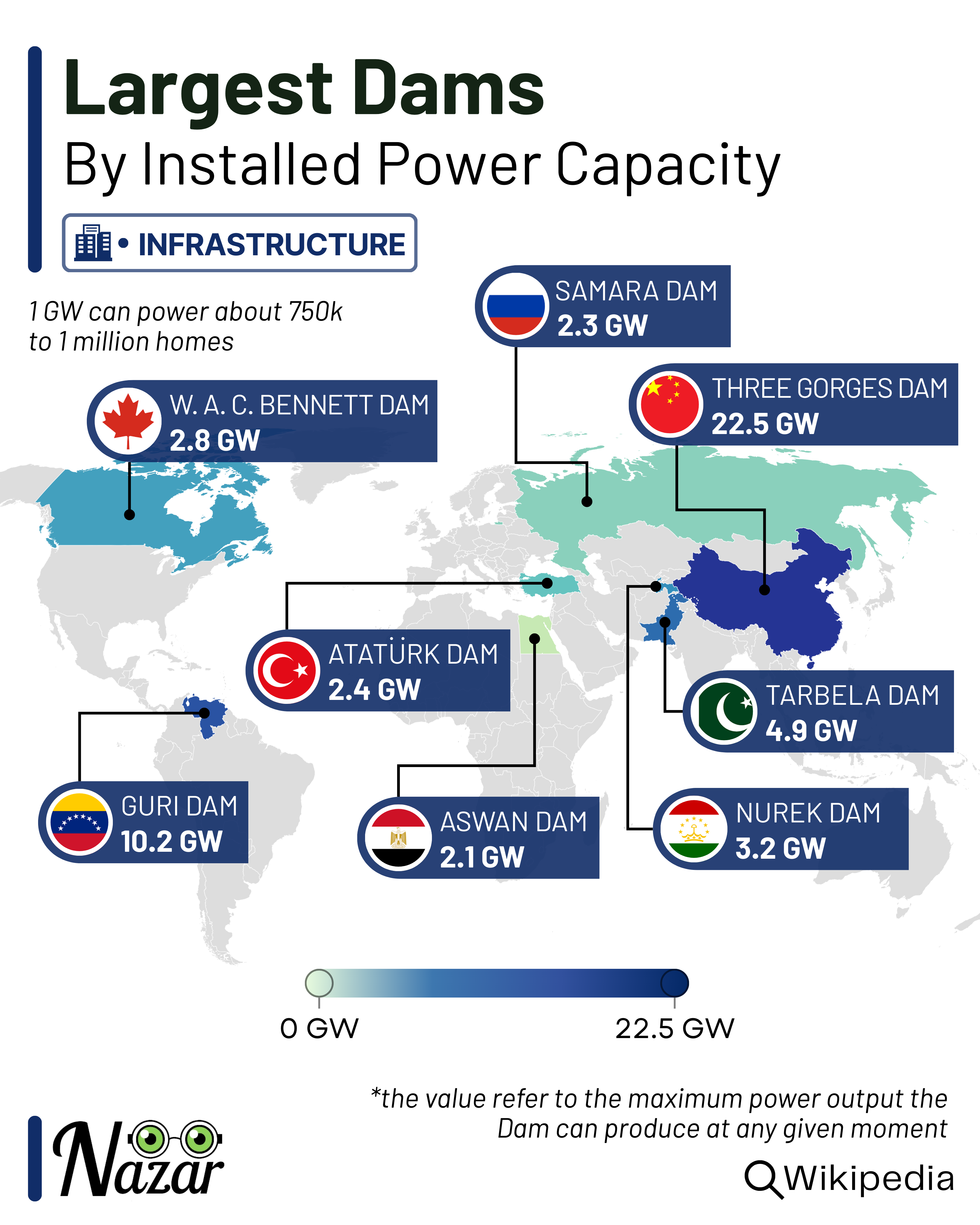Largest Dams Map


David Chen
Data Visualization Specialist
David Chen is an expert in transforming complex geographic datasets into compelling visual narratives. He combines his background in computer science ...
Geographic Analysis
What This Map Shows
The "Largest Dams Map" provides a comprehensive visualization of the world’s largest dams by height and volume. These monumental structures are not just feats of engineering; they play crucial roles in water management, energy production, and regional development. The map highlights their locations, showcasing how these massive constructions are strategically placed across various countries, often in areas where they can harness the power of rivers. In the following sections, we will delve deeper into the significance of these dams, exploring their functions, regional distributions, and the impact they have on both the environment and local communities.
Deep Dive into Dams
Dams serve multiple purposes, but at their core, they are built to manage water resources effectively. Primarily, they are used for hydroelectric power generation, irrigation, flood control, and recreation. The construction of a dam alters the natural flow of a river, creating a reservoir that can store immense quantities of water. This stored water can then be released in a controlled manner to provide irrigation during dry seasons, generate electricity, and even mitigate flood risks downstream.
Interestingly, the largest dams in the world, such as the Three Gorges Dam in China and the Itaipu Dam in Brazil, reflect not only engineering prowess but also economic strategies. The Three Gorges Dam, which stands at 185 meters and stretches over 2,300 meters in length, is the largest hydroelectric power station in the world by installed capacity, generating over 22,500 megawatts of power. This dam has significantly influenced China's energy landscape, contributing to the country’s rapid industrialization and urbanization.
In terms of environmental impact, the creation of large reservoirs can drastically change local ecosystems. Aquatic habitats may be submerged, and species that rely on the natural flow of rivers can be adversely affected. Furthermore, the displacement of communities is often a critical issue associated with dam construction. In some cases, entire villages are relocated to make way for new reservoirs, leading to social upheaval and loss of cultural heritage.
Interestingly, not all dams are created equal when it comes to their environmental footprint. For instance, smaller, run-of-the-river dams tend to have a lesser impact on local ecosystems compared to massive storage dams. Nevertheless, the ongoing discussions around dam construction and its implications for biodiversity highlight the need for a balanced approach to water resource management.
Regional Analysis
When examining the distribution of the largest dams, we can see distinct patterns emerge across different regions. In North America, for example, the Hoover Dam stands as a symbol of engineering innovation, providing water and power to millions in the southwestern United States. In contrast, Asia is home to the majority of the world’s largest dams, with China leading the way. The Yangtze River, for instance, has several significant dams that serve both economic and residential needs in densely populated regions.
In Africa, the Grand Ethiopian Renaissance Dam has been a focal point of regional politics, as it promises to provide much-needed electricity to Ethiopia and its neighbors. However, its construction has raised concerns among downstream countries like Egypt, which relies on the Nile River for its water supply. This demonstrates how the management of water resources can lead to geopolitical tensions, highlighting the intricate balance between development and cooperation.
South America, on the other hand, showcases the Itaipu Dam, which straddles the border between Brazil and Paraguay. It not only serves as a major energy source but also as a collaborative project between the two nations, indicating how dams can foster international partnerships.
Significance and Impact
The significance of dams transcends their physical presence; they shape economies, communities, and environments. As global populations grow and climate change impacts water availability, the role of dams will become even more critical. The ability to store and manage water resources efficiently will be essential for food security, energy production, and flood management.
Current trends suggest an increased focus on sustainable water management practices, including the consideration of environmental impacts during the planning stages of dam projects. Alternatives such as small-scale hydro and the rehabilitation of existing dams are being explored to mitigate the negative consequences often associated with large-scale constructions.
Moreover, as technology advances, innovations in dam management and design may lead to more environmentally friendly approaches. For example, fish ladders and bypass systems are being integrated into new projects to help preserve aquatic life.
In conclusion, the "Largest Dams Map" serves as a reminder of the powerful intersection between human ingenuity and natural resources. Understanding the role of these structures is vital as we navigate the complexities of modern water management challenges, ensuring they serve both human needs and environmental health.
Visualization Details
- Published
- August 14, 2025
- Views
- 124
Comments
Loading comments...